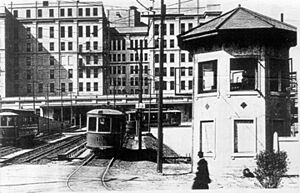Newark Public Service Terminal facts for kids
The Public Service Terminal was a big station for streetcars (also known as trolleys) in Newark, New Jersey. It had three levels and was owned by the Public Service Corporation. This company was special because it ran transportation and also provided electricity and gas to homes and businesses in northern New Jersey.
The terminal was right next to the Hudson and Manhattan Railroad's Park Place station. It was the final stop, or "terminus," for streetcar lines that came from places as far away as Trenton. The building also had six floors of offices above the station, which served as the company's main headquarters.
Contents
A Busy Hub for Streetcars
The Public Service Terminal opened on April 30, 1916. It was located at the corner of Park Place and Raymond Boulevard, near Military Park. This spot was just a few blocks from a very busy area downtown called Broad and Market Streets.
Why the Terminal Was Important
The terminal was built to give streetcars a special place to stop off the main streets. This helped keep traffic moving smoothly. It also created a central spot where many riders could easily get on or off the streetcars.
The main entrance to the building was between the two track levels. This entrance led to the office floors and to both parts of the terminal.
How the Levels Worked
Most streetcars used the upper level of the terminal. They reached this level by driving up a ramp from Mulberry Street on the east side. Some streetcars used the lower level. These cars got there from Washington Street on the west side, by using a two-block long tunnel called the Cedar Street Subway.
In 1916, the upper level was very busy, seeing about 2,050 streetcars every day. The lower level had about 550 cars daily. More than 50,000 fares were paid each day at the terminal!
Connecting to the Subway
In 1935, the lower level of the terminal was connected to the new City Subway. This subway ran under Raymond Boulevard, right next to the terminal. The connection allowed streetcars to continue their journey to the subway terminal at Penn Station. The connection for eastbound cars even passed under the City Subway to avoid crossing its tracks.
From Streetcars to Buses
Like many streetcar companies, Public Service started changing its routes to bus lines during the 1930s. Buses became a more popular way to travel.
The Last Streetcars
The very last streetcar line to use the upper level of the terminal was the #1-Newark line. This line went to Exchange Place Terminal in Jersey City. It stopped running on August 1, 1937.
The last streetcar line on the lower level was the #43-Jersey City line. It also went to Exchange Place Terminal but took a different route. This line ended on May 1, 1938.
Continuing as a Bus Terminal
Even after the streetcars stopped, the Public Service Terminal continued to be used for bus routes. The lower level was used by buses until May 1966. The upper level kept serving buses until 1978.
The Terminal's End and New Beginnings
In 1981, Public Service sold its transportation system to New Jersey Transit. This included a large network of bus lines and the City Subway.
The Public Service Terminal building was torn down in June 1981. A new building, called 80 Park Plaza, was built in its place. This new building became the headquarters for the Public Service Enterprise Group, which is the modern version of the old Public Service Corporation.
What Remains Today
Even though the terminal is gone, some parts of its history still exist. The unused Cedar Street Subway tunnel, from its entrance to a wall east of Broad Street, is still there. Also, the City Subway tunnel is now part of the Newark Light Rail's Broad Street branch. It comes out of the ground at Centre Street.
Images for kids




